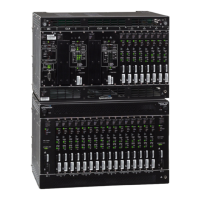1
097-55501-01 Issue 6 – June 2003 67
2
5
3
Engineering & Ordering
For protected outputs, a card is inserted into each of the slots of the pair.
For example, if one card is inserted into each slot of the “A” group, 40
protected outputs are provided.
2.3.4 Timing Output Cabling
Output port designations are as shown in Figure 2-2 for the master and
remote shelf, and Figure 2-3 for the expansion shelf. Each letter indicates a
group of 40 ports; each number indicates a port.
2.4 LAN Communication Port
Configuration of TimeHub network parameters for the master and remote
shelf, such as IP address, subnet mask, and gateway IP can be set through
the local RS-232 (serial) port, accessible either from the management card
plug-in on the front of the shelf or the “local” connection along the top on
the rear of the shelf. Once the IP address has been set and a LAN connection
made, the TimeHub 5500 can be accessed remotely via network.
To do this, obtain network parameters values from the system
administrator, connect the LAN cable from the network to the LAN connector
on the rear of the shelf, then configure the network parameters using TL1
commands. See Procedure 4-9 for details (Chapter 4, under System
Configuration).
2.5 Ordering and Parts List
Table 2-1 lists the basic components that should be ordered when
ordering a master or remote shelf.
N
OTE
: Slot “D” on the master or remote shelf can only support
20 outputs.

